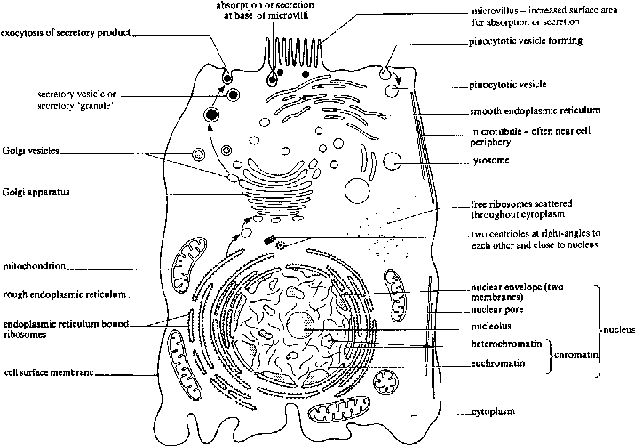Cell organization
Structure of Cell of Class 11
Depending upon origin, cells are of three types:
(a) Prokaryotic cell e.g. bacteria, cyanobacteria, archaebacteria, Mycoplasma, Rickettsiae.
Size - 0.1 – 5µ; Volume 0.2 – 10 µm3; DNA : RNA ratio - 1 : 2.
They have only one envelope system. Membrane bound cell organelles are absent.
Circular DNA is not associated with histones.
Well defined nucleus absent. The clear nuclear area shows a tangled DNA called as nucleoid/genophore/prochromosome.
Amount of DNA remains constant throughout the life cycle.
Spindle apparatus not formed during cell division.
Cell membrane may be folded to form mesosome that acts as site of respiration.
Flagella if present are single-stranded.
Ribosomes typically of 70S size.
(b) Eukaryotic cell
Size 3 – 30 µ ; Cell volume 1000 – 10,000 µm3; DNA : RNA – 1 : 1.
Two envelope organisation.
True nucleus and intracellular compartments present.
Microbodies i.e. peroxisomes, glyoxysomes, lysosomes bounded by single membrane.
Nucleus, plastids, mitochondria are bounded by double membrane.
Organelles like ribosomes, centrioles, microfilaments are without membrane.

Fig. Ultrastructure of a generalised animal cell
Cytoplasmic Ribosomes-80S type and Organelle Ribosomes-70S type.
Flagella, if present, are 11-stranded.
Nuclear DNA associated with histone proteins.
Nuclear DNA linear. Extra-nuclear DNA circular.
Amount of DNA shows regular alteration between diploid and haploid stages.
Spindle apparatus produced during cell division.
(c) Mesokaryotic cell
Histone proteins absent but nucleus present.
Chromosomes are condensed in interphase.
Cell division by dinomitosis, e.g. Dinoflagellates.
- Introduction of Cell
- Concept of Protoplasm
- Theory of Cell
- Cell organization
- Cell Size
- Cellular Totipotency
- Types of Cell
- Flow of Information
- Structure of Cell
- Cell Membrane
- Endoplasmic Reticulam
- Golgi Appratus
- Lysosomes
- Mitochondria
- Plastids
- Nucleus
- Chromosomes
- Ribosomes/Palade Particles/Protein Factories
- Microbodies
- Centrioles
- CILIA AND FLAGELLA
- Cytoskeletal Structures
- Cytoskeletal Structures
- Exercise 1
- Exercise 2
- Exercise 3
- Exercise 4
- Exercise 5
- Exercise 6









